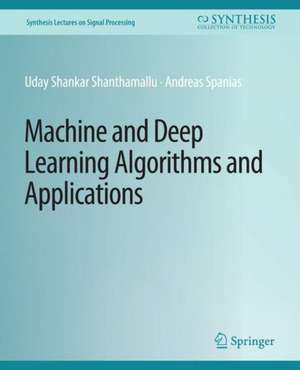Machine and Deep Learning Algorithms and Applications: Synthesis Lectures on Signal Processing
Autor Uday Shankar Shanthamallu, Andreas Spaniasen Limba Engleză Paperback – 22 dec 2021
Din seria Synthesis Lectures on Signal Processing
-
 Preț: 350.72 lei
Preț: 350.72 lei -
 Preț: 412.42 lei
Preț: 412.42 lei -
 Preț: 351.41 lei
Preț: 351.41 lei -
 Preț: 191.30 lei
Preț: 191.30 lei - 15%
 Preț: 594.24 lei
Preț: 594.24 lei -
 Preț: 387.59 lei
Preț: 387.59 lei -
 Preț: 260.18 lei
Preț: 260.18 lei -
 Preț: 259.04 lei
Preț: 259.04 lei -
 Preț: 415.57 lei
Preț: 415.57 lei -
 Preț: 247.72 lei
Preț: 247.72 lei -
 Preț: 191.30 lei
Preț: 191.30 lei -
 Preț: 360.50 lei
Preț: 360.50 lei -
 Preț: 387.96 lei
Preț: 387.96 lei -
 Preț: 234.87 lei
Preț: 234.87 lei -
 Preț: 234.87 lei
Preț: 234.87 lei -
 Preț: 351.41 lei
Preț: 351.41 lei -
 Preț: 388.52 lei
Preț: 388.52 lei -
 Preț: 427.88 lei
Preț: 427.88 lei -
 Preț: 267.31 lei
Preț: 267.31 lei
Preț: 413.27 lei
Nou
Puncte Express: 620
Preț estimativ în valută:
79.08€ • 82.79$ • 65.43£
79.08€ • 82.79$ • 65.43£
Carte tipărită la comandă
Livrare economică 07-21 aprilie
Preluare comenzi: 021 569.72.76
Specificații
ISBN-13: 9783031037481
ISBN-10: 3031037480
Pagini: 107
Ilustrații: XV, 107 p.
Dimensiuni: 191 x 235 mm
Greutate: 0.23 kg
Editura: Springer International Publishing
Colecția Springer
Seria Synthesis Lectures on Signal Processing
Locul publicării:Cham, Switzerland
ISBN-10: 3031037480
Pagini: 107
Ilustrații: XV, 107 p.
Dimensiuni: 191 x 235 mm
Greutate: 0.23 kg
Editura: Springer International Publishing
Colecția Springer
Seria Synthesis Lectures on Signal Processing
Locul publicării:Cham, Switzerland
Cuprins
Table of Contents:Preface.- Acknowledgments.- Introduction to Machine Learning.- Supervised Learning.- Unsupervised Learning.- Semi-Supervised Learning.- Neural Networks and Deep Learning.- Machine and Deep Learning Applications.- Conclusion and Future Directions.- Bibliography.- Authors' Biographies.
Notă biografică
Uday Shankar Shanthamallu received his Ph.D. degree in 2021 from the school of Electrical,Computer, and Energy Engineering at Arizona State University. He received his Master’s degree in electrical engineering from Arizona State University in 2018 and a Bachelor’s degree in electronics and communication engineering from the National Institute of Engineering, India,in 2011. His research interests include representation learning for graphs using machine learning and deep learning techniques. He also has experience on sensor data analytics for anomaly detection. His internship with NXP Semiconductors (2016) focused on algorithm development for sensor data analytics. He also interned with Lawrence Livermore National Laboratory during the summer of 2019 and 2020 where he built predictive models for human brain connectomes.
Andreas Spanias is Professor in the School of Electrical, Computer, and Energy Engineering at Arizona State University. He is also the director of the Sensor Signal and Information Processing (SenSIP) center and the founder of the SenSIP industry consortium (also an NSF I/UCRC site). His research interests are in the areas of adaptive signal processing, speech processing, machine learning and sensor systems. He and his student team developed the computer simulation software Java-DSP and its award-winning iPhone/iPad and Android versions. He is author of two textbooks: Audio Processing and Coding by Wiley and DSP: An Interactive Approach (2nd ed.). He contributed to more than 350 papers, 11 monographs, 11 full patents, 10 provisional patents, and 12 patent pre-disclosures. He served as Associate Editor of the IEEE Transactions on Signal Processing and as General Co-chair of IEEE ICASSP-99. He also served as the IEEE Signal Processing Vice-President for Conferences. Andreas Spanias is co-recipient of the 2002 IEEE Donald G. Fink paper prize award and was elected Fellow of the IEEE in 2003. He served as Distinguished Lecturer for the IEEE Signal Processing Society in 2004. He is a series editor for the Morgan & Claypool lecture series on algorithms and software. He received the 2018 IEEE Phoenix Chapter award with citation: “For significant innovations and patents in signal processing for sensor systems.” He also received the 2018 IEEE Region 6 Outstanding Educator Award (across 12 states) with citation: “For outstanding research and education contributions in signal processing.” He was elected recently to Senior Member of the National Academy of Inventors (NAI).
